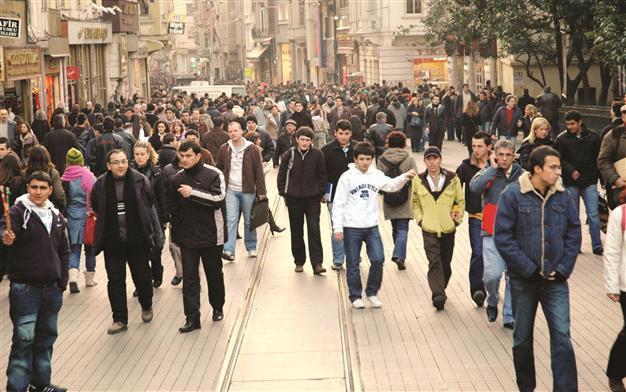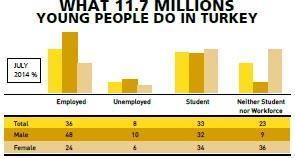One third of youth neither at work nor at school in Turkey
Mustafa Sönmez - mustafasnmz@hotmail.com

While 58 percent of young men are active in the workforce, the rate of young women active in the workforce is just 29 percent.
As the world and Turkey proceed toward economic shrinkage, it is the young population that is the most anxious. While youth unemployment is rapidly increasing, especially in the European Union, in Turkey the concerns of the young population are increasing regarding both access to education and access to employment.
Eurostat data reveal that youth employment in Europe, especially in Mediterranean countries, has reached jaw dropping levels. Turkish Statistical Institute (TÜİK) data also points out that young people in Turkey have significant problems in access to education and employment.
According to the July 2014 Household Workforce data, the Turkish population in the 15-24 age group is currently 11.7 million and roughly a third of them are in education. Another third is working, while the final third is either unemployed because they have not been able to find a job or they are neither at school nor holding a job. In other words, they are outside the workforce. This number has reached 3.7 million.
 Inadequate schooling
Inadequate schooling While the rate of young people who attend secondary school is 76 percent, the number rate who head to higher education is approaching 40 percent. This means they are out of school.
Meanwhile, as of July 2014, the number of those who were out in the market looking for jobs was nearly 5.2 million. However, while only 4.2 million of them are employed, nearly 1 million are unemployed. Consequently, according to the total of 5.2 million of the workforce, 18 people out of every 100 cannot find work.
This 18 percent of youth unemployment varies regionally. Youth unemployment in the east and the southeast reaches 30 percent. But, in some western big cities it is also scary. For example, in İzmir it is 27 percent, while in both Bursa and Kocaeli it is 25 percent.
Men in employment Among the 4.2 million youths who were able to find a job and who work, men make up two thirds of them.
There are 5.9 million young women between the ages of 15-24, and they lag behind men both in education and in employment. While 58 percent of young men are active in the workforce, only 29 percent of young women are.
While 32 percent of young males are students, this rate is 34 percent among women. Out of all young people in education, men constitute 49 percent and young women constitute 51 percent.
Among Turks aged 15-24, the rate of those who neither go to school nor work is one third. Out of them, 8 percent of the population is “unemployed" - those who cannot find a job even though they are looking for one. However, 23 percent neither go to school nor are in the workforce market. This young population "in transition" is nearing 3.7 million; some 2.5 million are young women and 1.2 million are young men.
Out of the 2.2 million out of school-out of workforce, young women constitute 36 percent of the total population of young women. One reason creating this situation is the difficulty young people face in accessing secondary education in rural areas, especially in less developed regions; another factor is the behavior of conservative families of not sending young girls either to school or to work.
In big cities such as Istanbul and İzmir, while this trend is broken to a small extent due to the living conditions, in a large portion of Anatolia, especially in the cities, both education and jobs are shut down to young women by the patriarchal family order and the number of young girls who are neither in school nor in jobs reaches 2.2 million. When the 350,000 young women who cannot find jobs even though they are looking for them are added, the total number of unemployed young women becomes 2.5 million.
For young men, on the other hand, the number of those who are neither at work nor at school has reached 540,000, corresponding to the 9 percent of the young male population. When the nearly 600,000 young men who cannot find jobs even though they are looking for them are added, the total number of inactive young men becomes 1.2 million.
 Youth unemployment in Europe
Youth unemployment in EuropeWith the global crisis, youth unemployment in Europe has become one of the biggest problems. Starting in 2008, which is considered the first year of the crisis, youth unemployment increased rapidly. Those who joined employment from the 15-24 age group reduced rapidly, especially in the Mediterranean members of the EU; the youth are in a situation where they have not been able to find jobs for years. Compared to this situation, Turkey stands at a place near the average, both in terms of employment and in terms of youth employment.
According to Eurostat data, in the 28 member EU community, the participation of the young population in employment was 37 percent 2008. In 2012, this had dropped 5 percentage points to 32 percent. In the eurozone, the decline was 6.2 percentage points.
Across the EU, youth unemployment rose from 16 percent to over 23 percent during the crisis. But the declines in employment and increases in unemployment are not the same across the entire EU; in some countries there is a scary picture, while others appear relatively good.
While youth employment in northern Europe is higher, in southern Europe it is lower. The south also has a darker picture in youth unemployment.
In the Netherlands, although youth employment has dropped since the crisis hit, it is still high at 62 percent. Youth unemployment is 11 percent. In Germany, youth employment dropped nearly 6 points and now only 47 percent of the young population is employed. Despite this, however, the unemployment rate is only 8 percent. The U.K. and Sweden, meanwhile, are in a relatively better place in youth employment and unemployment.
The real problem is in southern, central and eastern Europe…
France has a huge problem, and can only employ about 30 percent of its youth, with youth unemployment at nearly 24 percent. As can be easily estimated, other countries that have the biggest problems in the youth department are the Mediterranean countries.
In Spain, youth employment, which was already 36 percent in 2008, has dropped to as low as 17 percent. Youth unemployment has risen to a jaw-dropping 55 percent.
The same goes for Italy. Youth unemployment in Italy has skyrocketed during the crisis from 21 percent to 40 percent. Greece and Portugal are also in serious trouble. In Greece, 58 percent of the youth is unemployed and only 12 percent have jobs.
Compared to these terrible figures, Turkey's middling performance doesn't appear too catastrophic.

 Inadequate schooling
Inadequate schooling  Youth unemployment in Europe
Youth unemployment in Europe